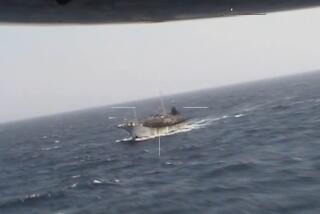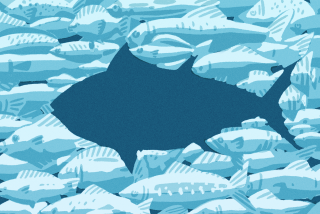A Hands-On Approach to Tuna Fishing
- Share via
Even while the U. S. tuna industry has changed drastically over the years, for Eddie Diehl and a small group of San Diego fishermen, the method of tuna fishing has remained the same. Diehl, 66, and about nine other San Diego bait boat owners still use poles to catch tuna, much like fishermen did at the turn of the century.
“We fish the way it was always done,” Diehl said recently as he readied his boat for a 30- to 40-day trip to the North Pacific. “We always will.”
And in the midst of controversy over the killing of porpoise during other tuna fishing operations, their traditional method has gained the support of environmentalists.
While tuna purse seining is being assailed, bait boat fishing is being praised.
‘Honest Fishing’
“This is honest fishing,” said Sam LaBudde, a biologist who works with Earth Island Institute, an activist group. “It’s done in a respectable manner and doesn’t adversely impact the ecosystem. It’s a very responsible method of fishing.”
LaBudde gained notoriety in 1987 when he returned from a four-month undercover stint as a crewman aboard a foreign purse seiner. He came back with graphic film footage of dying dolphins, highly evolved mammals that often congregate with schools of tuna and become ensnared in fishermen’s nets.
“I have nothing but praise for bait boat fishermen,” LaBudde said.
Bait boats, so-called because live anchovies and sardines are used to lure schools of tuna, gave rise to the industry. Tuna seiners--named for the purse seine, or net, that is used to catch the fish--were introduced in the late 1950s and early 1960s. Few people outside the industry know that bait boats have survived the competition with the huge, sleek seiners.
Bait boats use nets only to catch the bait close to shore, where porpoise rarely venture. Farther from the coast, the bait is tossed overboard to attract tuna schools. Porpoise do not bite on the barbed lures used by the pole fishermen.
Bait fishermen typically use one or two poles to haul in a tuna, although the three-pole method is used when bigger fish are anticipated. In the two-pole method, two fishermen stand with poles tied into a single, 6-foot fishing line with one barbless “squid” lure at the end. The leader of the team is the person stationed on the right and who coordinates the effort.
The tuna, in a feeding frenzy because of the bait, bites on the lure and is hauled on board in a whipping motion. When the pull from the line eases, the lure releases from the tuna’s mouth and the fish falls on deck. Although larger tuna, which weigh 40 pounds or more, could pull a single pole fisherman overboard, an experienced fisherman’s technique allows someone else to gaffe the fish.
Bait boat operators such as Diehl have stuck to pole fishing because of the challenge it represents, said Bill Perkins, general manager of the Western Fishboat Owners Assn., which negotiates tuna prices and licensing procedures. The pole fishing method poses no threat to marine mammals, nor does it threaten depletion of tuna stocks, he said.
Bait boats gave rise to the tuna industry. The first tuna was canned in 1909, and for decades San Diego was the hub of the industry. At its height, San Diego was home port to nearly 300 tuna vessels and the site of six canneries.
The purse seine fleet based here has shrunk to about 28 because of increased competition from foreign boats, and the last San Diego cannery closed in 1984. The only remaining cannery in the mainland United States is Pan Pacific Fisheries in San Pedro, Calif., where most bait operators sell their catch.
The bait boats--San Diego is home port to about 10--generally range in size between 50 and 150 tons. Purse seiners range between 750 and 1,500 tons. The crew aboard a bait boat is made up of five to eight people. On a purse seiner, crew size varies between 12 and 22. The trips are usually shorter on bait boats, averaging 30 to 60 days, while seiners are at sea for two to three months.
“It’s a lot more fun, let’s put it that way,” Diehl said. “A lot of people still fish bait because of the fun of it. You get into a school of fish and they are really biting.”
Uses Bamboo Poles
Diehl got started on bait boat fishing in the 1950s and later went into sport fishing. He returned to bait fishing 12 years ago and still uses bamboo poles, although others have switched to fiberglass.
The bait boats are equipped with televisions, microwave ovens and assorted other conveniences.
“A lot of people think we live lousy at sea,” said boat operator Bob Pringle. “We live good. We have showers. Nobody ever starves, we have plenty of food. If we ever do run out, there’s plenty of fish, which is better for you anyway.”
It was the challenge of bait fishing that kept Pringle, 52, from permanently switching to a purse seine vessel. He has been a bait boat fisherman since age 16.
“It’s man against the fish,” Pringle said. “Sometimes the fish will take you down. I’ve seen old-timers not let go of the pole and be pulled right off the boat.”
When most of the fishermen switched over to purse seiners in the late ‘50s and early ‘60s, he said, it “was a madhouse.”
‘They Thought I Was Nuts’
“The first two trips I made, I wasn’t sure what I got myself into. I had just gotten married, all my family went into purse seining. I told my wife this wasn’t my cup of tea. I went back into albacore fishing. They thought I was nuts.”
Pringle bought his first bait boat in 1964 and now owns two. While those who went into purse seiners at times have reaped huge profits, Pringle said he is able to gross about $1 million annually during a good year.
A year is hard to predict, however, because of volatile market conditions, he said. “Nobody got rich bait fishing. We struggled. Believe me, we struggled.”
While bait boats cannot produce the volume purse seiners do, they are able to stay in business through a combination of factors, said the fishing boat association’s Perkins.
Canneries prefer to buy fish caught from bait boats because it is often fresher, he said. Bait boats are also more efficient at catching albacore tuna, the “white meat” tuna that brings a higher price, although they also catch yellowfin and skipjack tuna, which are sold as “chunk light” in grocery stores.
There would probably be more bait boats if more fishing permits could be obtained from Mexico, Perkins said. The limited number of permits available do not allow tuna vessels to go within Mexico’s 12-mile territorial limit, which is where the bait is caught.
One of Pringle’s boats, the Karen Kristie, was seized by the Mexican navy for allegedly violating territorial waters in 1987. It was released later that year.
The one point of common ground between the U. S. tuna industry and environmentalists is the threat posed by gill and drift net fishing. In the South Pacific, boats from Japan, South Korea and Taiwan unfurl spidery nets up to 35 miles long and 25 feet deep. The nets are hauled in with albacore tuna and swordfish, but also sharks, seals, turtles, whales, dolphins and even hundreds of birds.






